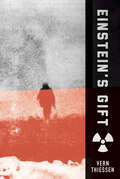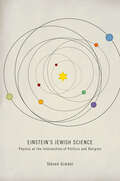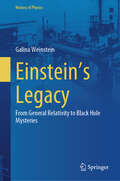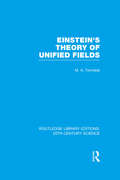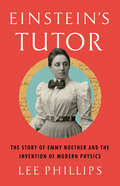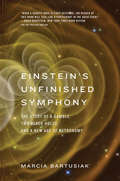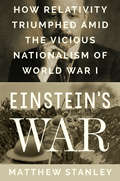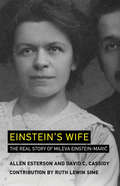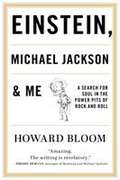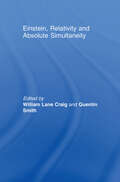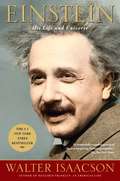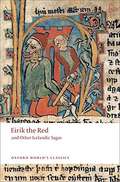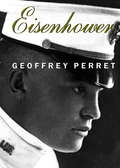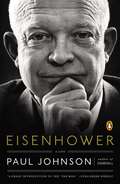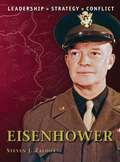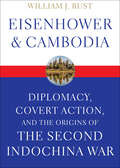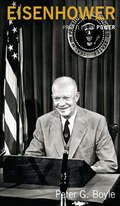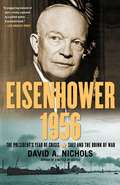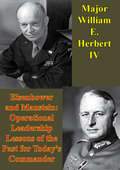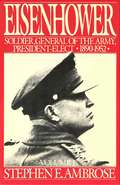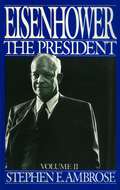- Table View
- List View
Einstein's Gift
by Vern ThiessenEinstein’s Gift follows the life and work of Nobel laureate Dr. Fritz Haber, a man who risked everything for a country that never accepted him. Haber, a chemist who worked hard to enhance life, discovered too late that when his knowledge was put in the hands of the wrong people, millions would die and that his efforts to serve humanity were futile against political will, nationalism, and war. This updated edition of Vern Thiessen’s compelling play about the collision of power and pride still resonates with verve and vigour.
Einstein's Greatest Mistake: A Biography
by David Bodanis&“What Bodanis does brilliantly is to give us a feel for Einstein as a person. I don&’t think I&’ve ever read a book that does this as well . . . Whenever there&’s a chance for storytelling, Bodanis triumphs.&” —Popular Science &“Fascinating.&” —Forbes Widely considered the greatest genius of all time, Albert Einstein revolutionized our understanding of the cosmos with his general theory of relativity and helped lead us into the atomic age. Yet in the final decades of his life, he was ignored by most working scientists, and his ideas were opposed by even his closest friends. How did this happen? Best-selling biographer David Bodanis traces the arc of Einstein&’s life—from the skeptical, erratic student to the world&’s most brilliant physicist to the fallen-from-grace celebrity. An intimate biography in which &“theories of the universe morph into theories of life&” (Times, London), Einstein&’s Greatest Mistake reveals what we owe Einstein today—and how much more he might have achieved if not for his all-too-human flaws.
Einstein's Jewish Science: Physics at the Intersection of Politics and Religion
by Steven GimbelFinalist for the Gerrard and Ella Berman Memorial Award of the Jewish Book CouncilIs relativity Jewish? The Nazis denigrated Albert Einstein’s revolutionary theory by calling it "Jewish science," a charge typical of the ideological excesses of Hitler and his followers. Philosopher of science Steven Gimbel explores the many meanings of this provocative phrase and considers whether there is any sense in which Einstein’s theory of relativity is Jewish. Arguing that we must take seriously the possibility that the Nazis were in some measure correct, Gimbel examines Einstein and his work to explore how beliefs, background, and environment may—or may not—have influenced the work of the scientist. You cannot understand Einstein’s science, Gimbel declares, without knowing the history, religion, and philosophy that influenced it. No one, especially Einstein himself, denies Einstein's Jewish heritage, but many are uncomfortable saying that he was being a Jew while he was at his desk working. To understand what "Jewish" means for Einstein’s work, Gimbel first explores the many definitions of "Jewish" and asks whether there are elements of Talmudic thinking apparent in Einstein’s theory of relativity. He applies this line of inquiry to other scientists, including Isaac Newton, René Descartes, Sigmund Freud, and Émile Durkheim, to consider whether their specific religious beliefs or backgrounds manifested in their scientific endeavors. Einstein's Jewish Science intertwines science, history, philosophy, theology, and politics in fresh and fascinating ways to solve the multifaceted riddle of what religion means—and what it means to science. There are some senses, Gimbel claims, in which Jews can find a special connection to E = mc2, and this claim leads to the engaging, spirited debate at the heart of this book.
Einstein's Legacy: From General Relativity to Black Hole Mysteries (History of Physics)
by Galina WeinsteinThis book offers a comprehensive exploration into the intertwined realms of Einstein's theory of general relativity, the discoveries of black holes, and the quantum conundrums that challenge our understanding of the universe. It delves into the fascinating journey from the birth of general relativity to the cutting-edge debates surrounding black holes, wormholes, and quantum physics. The narrative weaves through the historical milestones, including Schwarzschild's 1916 solution, the emergence of black holes in theoretical physics, and the ongoing quest to reconcile general relativity with quantum mechanics. Central to the book is exploring the information paradox and its implications for modern physics, shedding light on the profound questions and theoretical challenges that have captivated physicists for decades. It also critically examines the ER=EPR conjecture, a pivotal idea proposed by Leonard Susskind and Juan Maldacena, which suggests a deep connection between entangled quantumparticles and the structure of spacetime. In addition, the book engages with contemporary theoretical experiments on wormholes, framed within Nancy Cartwright's philosophical theories, offering a unique perspective on the reliability and interpretation of these groundbreaking scientific concepts. The main topics covered are not only crucial for understanding the universe but also embody the ongoing quest for a unified theory in physics. They represent the cutting edge of scientific inquiry, where the mysteries of black holes, the fabric of spacetime, and the perplexities of quantum mechanics converge. This book is designed for physicists, historians of science, and academically inclined readers interested in the evolution of theoretical physics and the groundbreaking ideas that have shaped our understanding of the cosmos. It offers a detailed yet accessible narrative, making it an invaluable resource for anyone seeking to grasp the complexities and triumphs of modern physics.
Einstein's Refrigerator: And Other Stories from the Flip Side of History
by Steve SilvermanUseless—and fascinating—information from the man with &“the reputation as the science teacher with 1,000 different stories to excite young minds&” (ABC News). Steve Silverman was looking for a way to add some spice to his high school lectures when he realized that weird and bizarre true-life stories would capture his students&’ attention. In fact, they worked so well that the science teacher then began posting his discoveries to his own Web site, which he dubbed Useless Information. Well-researched and clearly sourced, Silverman&’s unusual tidbits have gained a wide following. In Einstein&’s Refrigerator, Silverman collects more than thirty of the most fascinating stories he has gathered—tales of forgotten genius, great blunders, and incredible feats of survival, as well as answers to puzzling questions. Einstein&’s Refrigerator is a remarkable book with spellbinding stories. Whatever happened to the refrigerator Einstein helped invent? While it never became a commercial success, its underlying concepts became the basis for cooling nuclear breeder reactors.
Einstein's Theory of Unified Fields (Routledge Library Editions: 20th Century Science)
by Marie Antoinette TonnelatFirst published in1966, here is presented a comprehensive overview of one of the most elusive scientific speculations by the pre-eminent genius of the 20th century. The theory is viewed by some scientists with deep suspicion, by others with optimism, but all agree that it represents an extreme challenge. As the author herself affirms, this work is not intended to be a complete treatise or ‘didactic exposition’ of the theory of unified fields, but rather a tool for further study, both by students and professional physicists. Dealing with all the major areas of research which together comprise the development of a working model, the author ranges over conservation equations, variational principles, solutions of spherical symmetry, and treats a wide selection of Einstein’s own equations. The final chapter indicates problems associated with the unified field theory, in particular the energy-momentum tensor and geodesics.
Einstein's Tutor: The Story of Emmy Noether and the Invention of Modern Physics
by Lee PhillipsA revelatory story of the woman who made foundational contributions to science and mathematics and persevered in the face of discrimination. Emmy Noether's mathematical genius enabled Einstein to bring his General Theory of Relativity–the basis of our current theory of gravity–to fruition. On a larger scale, what came to be known as &“Noether&’s Theorem&”—called by a Nobel laureate &“the single most profound result in all of physics&”—supplied the basis for the most accurate theory in the history of physics, the Standard Model, which forms our modern theory of matter. Noether&’s life story is equally important and revelatory in understanding the pernicious nature of sexual prejudice in the sciences, revealing the shocking discrimination against one of the true intellectual giants of the twentieth century, a woman effectively excluded from the opportunities given to her male counterparts. Noether&’s personality and optimistic spirit, as Lee Phillips reveals, enabled her unique genius to persevere and arrive at insights that still astonish those who encounter them a century later.
Einstein's Unfinished Symphony: The Story of a Gamble, Two Black Holes, and a New Age of Astronomy
by Marcia BartusiakThis updated edition of the New York Times Notable Book recounts the long hunt for Einstein&’s predicted gravitational waves—and celebrates their discovery. In February 2016, astronomers announced that they had verified the last remaining prediction of Einstein&’s general theory of relativity—vibrations in space-time, called gravitational waves. Humanity can now tune in to a cosmic orchestra. We have heard the chirp of two black holes dancing toward a violent union. We will hear the cymbal crashes from exploding stars, the periodic drumbeats from swiftly rotating pulsars, and maybe even the echoes from the Big Bang itself. More than a decade earlier, Marcia Bartusiak chronicled the gamble taken by astronomers who were determined to prove Einstein right. In their quest to detect gravitational waves, they built the Laser Interferometer Gravitational-Wave Observatory (LIGO) detectors, the most accurate measuring devices ever created. In this updated edition, Bartusiak brings the story to a thrilling close with the triumphant discovery of gravitational waves made with the LIGO. "An important, multifaceted scientific story…part theoretical physics, part astronomy, part experimental physics, part engineering."—James Ryerson, New York Times Book Review
Einstein's War: How Relativity Triumphed Amid the Vicious Nationalism of World War I
by Matthew StanleyKIRKUS STARRED REVIEWPUBLISHER'S WEEKLY STARRED REVIEWThe birth of a world-changing idea in the middle of a bloodbath Einstein’s War is a riveting exploration of both the beauty of scientific creativity and enduring horrors of human nature. These two great forces battle in a story that culminates with a victory now a century old, the mind bending theory of general relativity. Few recognize how the Great War, the industrialized slaughter that bled Europe from 1914 to 1918, shaped Einstein’s life and work. While Einstein never held a rifle, he formulated general relativity blockaded in Berlin, literally starving. He lost 50 pounds in three months, unable to communicate with his most important colleagues. Some of those colleagues fought against rabid nationalism; others were busy inventing chemical warfare—being a scientist trapped you in the power plays of empire. Meanwhile, Einstein struggled to craft relativity and persuade the world that it was correct. This was, after all, the first complete revision of our conception of the universe since Isaac Newton, and its victory was far from sure. Scientists seeking to confirm Einstein’s ideas were arrested as spies. Technical journals were banned as enemy propaganda. Colleagues died in the trenches. Einstein was separated from his most crucial ally by barbed wire and U-boats. This ally was the Quaker astronomer and Cambridge don A.S. Eddington who would go on to convince the world of the truth of relativity and the greatness of Einstein. In May of 1919, when Europe was still in chaos from the war, Eddington led a globe-spanning expedition to catch a fleeting solar eclipse for a rare opportunity to confirm Einstein’s bold prediction that light has weight. It was the result of this expedition—the proof of relativity, as many saw it—that put Einstein on front pages around the world. Matthew Stanley’s epic tale is a celebration of how bigotry and nationalism can be defeated, and of what science can offer when they are.
Einstein's Wife: The Real Story of Mileva Einstein-Mari? (The\mit Press Ser.)
by David C. Cassidy Allen EstersonWas Einstein's first wife his uncredited coauthor, unpaid assistant, or his unacknowledged helpmeet? The real “Mileva Story.”Albert Einstein's first wife, Mileva Einstein-Marić, was forgotten for decades. When a trove of correspondence between them beginning in their student days was discovered in 1986, her story began to be told. Some of the tellers of the “Mileva Story” made startling claims: that she was a brilliant mathematician who surpassed her husband, and that she made uncredited contributions to his most celebrated papers in 1905, including his paper on special relativity. This book, based on extensive historical research, uncovers the real “Mileva Story.” Mileva was one of the few women of her era to pursue higher education in science; she and Einstein were students together at the Zurich Polytechnic. Mileva's ambitions for a science career, however, suffered a series of setbacks—failed diploma examinations, a disagreement with her doctoral dissertation adviser, an out-of-wedlock pregnancy by Einstein. She and Einstein married in 1903 and had two sons, but the marriage failed. Was Mileva her husband's uncredited coauthor, unpaid assistant, or his essential helpmeet? It's tempting to believe that she was her husband's secret collaborator, but the authors of Einstein's Wife look at the actual evidence, and a chapter by Ruth Lewin Sime offers important historical context. The story they tell is that of a brave and determined young woman who struggled against a variety of obstacles at a time when science was not very welcoming to women.
Einstein, Michael Jackson and Me: A Search for Soul in the Power Pits of rock and Roll
by Howard BloomHoward Bloom--called "the greatest press agent that rock and roll has ever known" by Derek Sutton, the former manager of Styx, Ten Years After, and Jethro Tull--is a science nerd who knew nothing about popular music. But he founded the biggest PR firm in the music industry and helped build or sustain the careers of our biggest rock-and-roll legends, including Michael Jackson, Prince, Bob Marley, Bette Midler, Billy Joel, Billy Idol, Paul Simon, Peter Gabriel, David Byrne, AC/DC, Aerosmith, Queen, Kiss, Grandmaster Flash and the Furious Five, Run DMC, ZZ Top, Joan Jett, Chaka Khan, and one hundred more. What was he after? He was on a hunt for the gods inside of you and me. Einstein, Michael Jackson & Me is Bloom's story--the strange tale of a scientific expedition into the dark underbelly of science and fame where new myths and movements are made. Based in Park Slope, Brooklyn, HOWARD BLOOM, also an extensive writer in the field of science, has been called "next in a lineage of seminal thinkers that includes Newton, Darwin, Einstein, [and] Freud" by Britain's Channel 4 TV, and "the next Stephen Hawking" by Gear magazine. One of Bloom's seven books, Global Brain, was the subject of an Office of the Secretary of Defense symposium with participants from the State Department, the Energy Department, DARPA, IBM, and MIT. Among other things, his insights into Michael Jackson may surprise you.
Einstein, Relativity and Absolute Simultaneity (Routledge Studies in Contemporary Philosophy)
by William Lane Craig Quentin SmithEinstein, Relativity and Absolute Simultaneity is an anthology of original essays by an international team of leading philosophers and physicists who have come together to reassess the contemporary paradigm of the relativistic concept of time. A great deal has changed since 1905 when Einstein proposed his Special Theory of Relativity, and this book offers a fresh reassessment of Special Relativity’s relativistic concept of time in terms of epistemology, metaphysics, and physics.
Einstein: His Life and Universe (Great Thinkers Ser.)
by Walter IsaacsonBy the author of the acclaimed bestsellers Benjamin Franklin and Steve Jobs, this is the definitive biography of Albert Einstein. How did his mind work? What made him a genius? Isaacson’s biography shows how his scientific imagination sprang from the rebellious nature of his personality. His fascinating story is a testament to the connection between creativity and freedom. Based on newly released personal letters of Einstein, this book explores how an imaginative, impertinent patent clerk—a struggling father in a difficult marriage who couldn’t get a teaching job or a doctorate—became the mind reader of the creator of the cosmos, the locksmith of the mysteries of the atom, and the universe. His success came from questioning conventional wisdom and marveling at mysteries that struck others as mundane. This led him to embrace a morality and politics based on respect for free minds, free spirits, and free individuals. These traits are just as vital for this new century of globalization, in which our success will depend on our creativity, as they were for the beginning of the last century, when Einstein helped usher in the modern age.
Eirik The Red And Other Icelandic Sagas (World's Classics)
by Gwyn JonesSelected by Gwyn Jones--the eminent Celtic scholar--for their excellence and variety, these nine Icelandic sagas include "Hen-Thorir," "The Vapnfjord Men," "Thorstein Staff-Struck," "Hrafnkel the Priest of Frey," "Thidrandi whom the Goddesses Slew," "Authun and the Bear," "Gunnlaug Wormtongue," "King Hrolf and his Champions," and the title piece.
Eisenhower
by Geoffrey PerretDrawing on newly available material, including Eisenhower's papers and diaries, author and military historian Geoffrey Perret offers a comprehensive portrait of the life, military exploits, political life, and presidency of Dwight D. Eisenhower (1890-1969). He covers several controversies including an alleged dalliance, Eisenhower's break with MacArthur in 1939, his opinion of Nixon, and his role in McCarthy's activities. Annotation c. Book News, Inc., Portland, OR (booknews.com)
Eisenhower
by Jim Newton"Newton's contribution is as cogent an inventory of Eisenhower's White House years as I've ever read. He blends masterful writing with historic detail and provides the value-added of Ike as the man and the leader."--Chuck Hagel, Distinguished Professor, Georgetown University; U.S. Senator (1997-2009)Newly discovered and declassified documents make for a surprising and revealing portrait of the president we thought we knew.America's thirty-fourth president was belittled by his critics as the babysitter-in-chief. This new look reveals how wrong they were. Dwight Eisenhower was bequeathed the atomic bomb and refused to use it. He ground down Joseph McCarthy and McCarthyism until both became, as he said, "McCarthywasm." He stimulated the economy to lift it from recession, built an interstate highway system, turned an $8 billion deficit in 1953 into a $500 million surplus in 1960. (Ike was the last President until Bill Clinton to leave his country in the black.) The President Eisenhower of popular imagination is a benign figure, armed with a putter, a winning smile, and little else. The Eisenhower of veteran journalist Jim Newton's rendering is shrewd, sentimental, and tempestuous. He mourned the death of his first son and doted on his grandchildren but could, one aide recalled, "peel the varnish off a desk" with his temper. Mocked as shallow and inarticulate, he was in fact a meticulous manager. Admired as a general, he was a champion of peace. In Korea and Vietnam, in Quemoy and Berlin, his generals urged him to wage nuclear war. Time and again he considered the idea and rejected it. And it was Eisenhower who appointed the liberal justices Earl Warren and William Brennan and who then called in the military to enforce desegregation in the schools.Rare interviews, newly discovered records, and fresh insights undergird this gripping and timely narrative.JIM NEWTON is a veteran journalist who began his career as clerk to James Reston at the New York Times. Since then, he has worked as a reporter at the Atlanta Constitution and as a reporter, bureau chief and editor at the Los Angeles Times, where he presently is the editor-at-large and author of a weekly column. He also is an educator and author, whose acclaimed biography of Chief Justice Earl Warren, Justice for All: Earl Warren and the Nation He Made, was published in 2006. He lives in Pasadena, CA.From the Hardcover edition.
Eisenhower
by Paul JohnsonAcclaimed historian Paul Johnson's lively, succinct biography of Dwight D. Eisenhower explores how his legacy endures today In the rousing style he's famous for, celebrated biographer Paul Johnson offers a fascinating portrait of Dwight D. Eisenhower, focusing particularly on his years as a five-star general and his time as the thirty-fourth President of the United States. Johnson chronicles President Eisenhower's modest childhood in Kansas, his college years at West Point, and his rapid ascent through the military ranks, culminating in his appointment as Supreme Commander of the Allied Forces in Europe during World War II. Beginning when Eisenhower assumed the presidency from Harry Truman in 1952, Johnson paints a rich portrait of his two consecutive terms, exploring his volatile relationship with then-Vice President Richard Nixon, his abhorrence of isolationism, and his position on the Cold War, McCarthyism, and the Civil Rights Movement. Johnson notes that when Eisenhower left the White House at age 70, reluctantly passing the torch to President-elect John F. Kennedy, he feared for the country's future and prophetically warned of the looming military-industrial complex. Many elements of Eisenhower's presidency speak to American politics today, including his ability to balance the budget and skill in managing an oppositional Congress. This brief yet comprehensive study will appeal to biography lovers as well as to enthusiasts of presidential history and military history alike.
Eisenhower
by Paul JohnsonAcclaimed historian Paul Johnson's lively, succinct biography of Dwight D. Eisenhower explores how his legacy endures today In the rousing style he's famous for, celebrated biographer Paul Johnson offers a fascinating portrait of Dwight D. Eisenhower, focusing particularly on his years as a five-star general and his time as the thirty-fourth President of the United States.Johnson chronicles President Eisenhower's modest childhood in Kansas, his college years at West Point, and his rapid ascent through the military ranks, culminating in his appointment as Supreme Commander of the Allied Forces in Europe during World War II. Beginning when Eisenhower assumed the presidency from Harry Truman in 1952, Johnson paints a rich portrait of his two consecutive terms, exploring his volatile relationship with then-Vice President Richard Nixon, his abhorrence of isolationism, and his position on the Cold War, McCarthyism, and the Civil Rights Movement. Johnson notes that when Eisenhower left the White House at age 70, reluctantly passing the torch to President-elect John F. Kennedy, he feared for the country's future and prophetically warned of the looming military-industrial complex.Many elements of Eisenhower's presidency speak to American politics today, including his ability to balance the budget and skill in managing an oppositional Congress. This brief yet comprehensive study will appeal to biography lovers as well as to enthusiasts of presidential history and military history alike.
Eisenhower
by Steven Zaloga Steve NoonDwight Eisenhower represented a fundamentally new type of military commander in the 20th century: commander as manager rather than the traditional warrior commander. Armies had become so large and military coalitions so dependent on politics that this new type of commander emerged. Eisenhower never fought in a single battle, but he commanded the most modern and powerfully armed force to fight in Europe. As Supreme Commander of the Allied Expeditionary Force, Eisenhower had at his disposal not only the British, US, and French armies, but the RAF, USAAF, Royal Navy and US Navy-Atlantic. This book explores every aspect of his military career.From the Trade Paperback edition.
Eisenhower & Cambodia: Diplomacy, Covert Action, and the Origins of the Second Indochina War (Studies In Conflict, Diplomacy, And Peace Ser.)
by William J. RustThis historical study examines America’s Cold War diplomacy and covert operations intended to lure Cambodia from neutrality to alliance.Although most Americans paid little attention to Cambodia during Dwight D. Eisenhower’s presidency, the global ideological struggle with the Soviet Union guaranteed US vigilance throughout Southeast Asia. Cambodia’s leader, Norodom Sihanouk, refused to take sides in the Cold War, a policy that disturbed US officials. From 1953 to 1961, his government avoided the political and military crises of neighboring Laos and South Vietnam. However, relations between Cambodia and the United States suffered a blow in 1959 when Sihanouk discovered CIA involvement in a plot to overthrow him. The failed coup only increased Sihanouk’s power and prestige, presenting new foreign policy challenges in the region.In Eisenhower and Cambodia, William J. Rust demonstrates that covert intervention in the political affairs of Cambodia proved to be a counterproductive tactic for advancing the United States’ anticommunist goals. Drawing on recently declassified sources, Rust skillfully traces the impact of “plausible deniability” on the formulation and execution of foreign policy. His meticulous study not only reveals a neglected chapter in Cold War history but also illuminates the intellectual and political origins of US strategy in Vietnam and the often-hidden influence of intelligence operations in foreign affairs.
Eisenhower (Profiles In Power)
by P G. BoyleEisenhower is the president who established America as a superpower. He had already launched his reputation as the leading US military figure in the Second World War and then as supreme commander of the land forces of the newly created NATO. This book looks at how Eisenhower held power in the political field, and to what extent his political career was a success. This text is ideal for undergraduate courses in 20th Century American History and American Studies.
Eisenhower 1956
by David. A. NicholsA gripping tale of international intrigue and betray-al, Eisenhower 1956 is the white-knuckle story of how President Dwight D. Eisenhower guided the United States through the Suez Canal crisis of 1956. The crisis climaxed in a tumultuous nine-day period fraught with peril just prior to the 1956 presidential election, with Great Britain, France, and Israel invading Egypt while the Soviet Union ruthlessly crushed rebellion in Hungary. David A. Nichols, a leading expert on Eisenhower's presidency, draws on hundreds of documents declassified in the last thirty years, enabling the reader to look over Ike's shoulder and follow him day by day, sometimes hour by hour as he grappled with the greatest international crisis of his presidency. The author uses formerly top secret minutes of National Security Council and Oval Office meetings to illuminate a crisis that threatened to escalate into global conflict. Nichols shows how two life-threatening illnesses--Eisenhower's heart attack in September 1955 and his abdominal surgery in June 1956--took the president out of action at critical moments and contributed to missteps by his administration. In 1956, more than two thirds of Western Europe's oil supplies transited the Suez Canal, which was run by a company controlled by the British and French, Egypt's former colonial masters. When the United States withdrew its offer to finance the Aswan Dam in July of that year, Egypt's president, Gamal Abdel Nasser, nationalized the canal. Without Eisenhower's knowledge, Britain and France secretly plotted with Israel to invade Egypt and topple Nasser. On October 29--nine days before the U.S. presidential election--Israel invaded Egypt, setting the stage for a "perfect storm." British and French forces soon began bombing Egyptian ports and airfields and landing troops who quickly routed the Egyptian army. Eisenhower condemned the attacks and pressed for a cease-fire at the United Nations. Within days, in Hungary, Soviet troops and tanks were killing thousands to suppress that nation's bid for freedom. When Moscow openly threatened to intervene in the Middle East, Eisenhower placed American military forces--including some with nuclear weapons--on alert and sternly warned the Soviet Union against intervention. On November 6, Election Day, after voting at his home in Gettysburg, Ike rushed back to the White House to review disturbing intelligence from Moscow with his military advisors. That same day, he learned that the United Nations had negotiated a cease-fire in the Suez war--a result, in no small measure, of Eisenhower's steadfast opposition to the war and his refusal to aid the allies. In the aftermath of the Suez crisis, the United States effectively replaced Great Britain as the guarantor of stability in the Middle East. More than a half century later, that commitment remains the underlying premise for American policy in the region. Historians have long treated the Suez Crisis as a minor episode in the dissolution of colonial rule after World War II. As David Nichols makes clear in Eisenhower 1956, it was much more than that.
Eisenhower And Manstein: Operational Leadership Lessons Of The Past For Today's Commanders
by Major William E. Herbert IVThe United States Military, the ultimate Instrument of national resolve, is centered on servicemen and women. Without effective leadership these men and women are ill equipped to succeed in combat and are unjustly put in harm's way. The commander at the operational level is the link between national policy and action. His actions, character and decisions are of historical importance. While this paper will not cover the full spectrum of operational leadership; the most important traits of operational leadership will be explored. Additionally, this paper will highlight recent failures in operational leadership and compare and contrast them with lessons learned from two diametrically opposed operational leaders of World War II, General Dwight Eisenhower and Field Marshall Erich von Manstein. Analysis will concentrate on the specific operations of the Normandy invasion and Kharkov. The analysis will not deconstruct the operations but rather center on the operational leadership traits each commander displayed and their importance to the operation. Finally the paper will show how the lessons of sixty-five years ago are applicable today and for the future.
Eisenhower Volume I: Soldier, General of the Army, President-Elect, 1890-1952
by Stephen E. AmbroseDwight Eisenhower was not exactly born into poverty, but the family's circumstances were at least austere. He was one of seven children; his father, a railway worker. But the family was strong and unified, the youngsters energetic and ambitious.<P> Ike made it to West Point, where he excelled in sports. He was a natural leader. But it was at Leavenworth years later, as a student at the war college, that his intellectual talent showed itself. He graduated first in his class.<P> The author draws in a wealth of previously unpublished information to give us this beautiful portrait. As a result Eisenhower emerges as complex, one who as the author states, ". . .was a good and great man."
Eisenhower Volume II: The President
by Stephen E. AmbroseEisenhower: The President, the second and concluding volume of Stephen Ambrose's brilliant biography, is the first assessment of a postwar President based on access to the entire record. It covers a wide range of subjects, including Eisenhower's rejection of the near-unanimous advice he received as President to use atomic weapons; his thinking on defense policy and the Cold War; his handling of a multitude of foreign-affairs crises; his attitudes and actions on civil rights; his views on Joseph McCarthy and on communism. Also illuminated are Eisenhower's relations with Nixon, Truman, Khrushchev, de Gaulle, and other world leaders. Ambrose provides us with an extraordinary portrait -- fairminded and enormously well-informed -- of the man, both decent and complex, who is increasingly regarded as one of the twentieth century's greatest Presidents.
